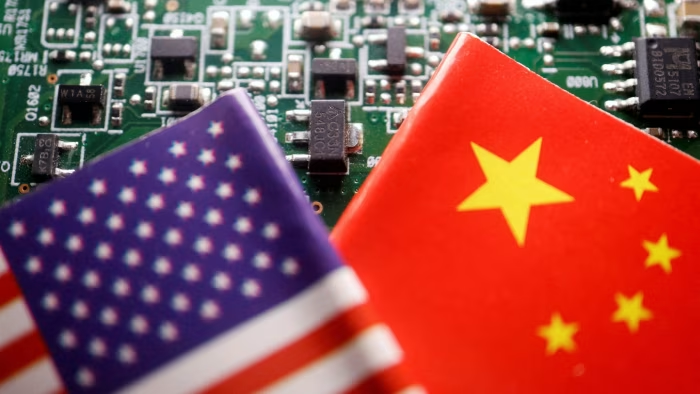Australia coach Andrew McDonald…
Scientists may have spotted ‘wind’ blowing from the Milky Way’s supermassive black hole.
Most supermassive black holes don’t just swallow up matter, they eject it, sometimes in spectacular jets of super…

Australia coach Andrew McDonald…

Scientists may have spotted ‘wind’ blowing from the Milky Way’s supermassive black hole.
Most supermassive black holes don’t just swallow up matter, they eject it, sometimes in spectacular jets of super…

The convicted child sexual abuser and former Lostprophets singer Ian Watkins has died after being attacked in prison.
He was attacked with a knife by another inmate on Saturday morning, sources confirmed to the PA news agency.
The 48-year-old was…

Jennifer Lopez is reportedly struggling both personally and professionally.
As per the latest report by RadarOnline.com, Lopez’s…

By Naeem Aslam
The Fed is making decisions without actual data – but investors are still banking on rate cuts
The U.S. government shutdown has sidelined the release of economic data, impairing the Federal Reserve’s judgment.
A defensive rotation into Treasury bonds, gold, high-grade corporate bonds and solid dividend-paying stocks would be likely.
The irony is rich: The U.S. Federal Reserve is about to walk into its next policy meeting in late October – scheduled for Oct. 28-29 – with less and less reliable information. The U.S. government shutdown has already halted the publication of critical data, including labor statistics, consumer-price index releases and more. At precisely the time when timely economic insight matters most, the Fed – and, by extension, markets – are being forced to navigate in the dark.
In a perceptive statement, Fed governor Stephen Miran stressed on Oct. 3 that shifts in policy should be founded on current availability of data – i.e., monthly jobs and inflation data. He repeated his earlier position that the “neutral interest rate” is above zero – contrary to some models which assume it to be close to zero – and suggested that cuts could be less steep or more fine-tuned than consensus expectation. Dovish but cautious, Miran makes a case for cuts, but not without clarity.
Read: The Fed hawks are battling the doves – and then there’s Stephen Miran
It’s not posturing. As the shutdown cripples Bureau of Labor Statistics activity, the Fed loses its gold-standard measures of labor-market conditions and inflation. Already, private substitutes like ADP’s (ADP) report – which noted a surprising loss of 32,000 jobs in September – are filling in, but they are less complete and less credible than the formal releases. (The BLS, indeed, said it would freeze data collection and releases until funding returns.) The loss hurts at the very center of Fed decision-making: Without new information, the committee might turn reactive rather than proactive.
What does the Fed do without new data?
Here are three likely scenarios:
1. Postpone or hold back: The Fed might decide to wait and hold back on rate cuts in October, giving forward guidance but not putting through additional cuts until data releases pick up again. That approach would signal caution, but it might lose steam if there are market expectations for moves.
2. Continue on trend and proxy data: Or, the Fed uses lagging indicators, staff internal forecasts and proprietary data (e.g., ADP, state employment surveys) to make educated guesses about trends. Here, their decision is more subjective and susceptible to error – especially at a macro turning point.
3. Conduct an aggressive, surprise cut: A daring (and risky) option would be cutting rates even in the absence of new data, on the argument that the risks of a decline are growing. This action could initiate bond rallies and intense equity gains – but also leave the Fed open to criticism for doing something that wasn’t supported by evidence.
History gives only qualified comparables. In prior shutdowns – for example, 2013 and 2018-2019 – there were some delays of data, but the Fed avoided surprise shocks and tended to follow anticipated pathways. This time, however, is unique: There are warning augurs of fissures for the economy, inflation is persisting and markets are on edge. A badly timed misstep or decision will have more spillovers now.
Labor data is the Fed’s guiding star – and the shutdown endangers it
Economic comparisons, even after data reporting returns, will be askew until normalization sets back in.
For decades, U.S. monthly nonfarm payrolls, the unemployment rate and average hourly earnings have been the Fed’s main measures of labor-market slack, wage pressure and the risk of inflation. These measures are used to calibrate whether policy is loose, neutral or too tight.
Without BLS data, the Fed’s compass loses its calibration. Aside from the technical difficulty, the shutdown has real economic impacts: More than 900,000 federal workers are said to be furloughed or working without pay, disrupting consumption, contracting demand and obscuring the baseline off which labor metrics are gauged. The extrication of the federal workforce from routine economic activity means comparisons, even after data reporting returns, will be askew until normalization sets back in.
Traders, confronted with this information void, could rely more on substitutes – regional Fed surveys, state reports and private payroll providers like ADP. Some institutions have already boosted exposure to defensive assets, volatility hedging and cash buffers, expecting broader sentiment swings. The longer the blackout continues, the more market action continues to decouple from fundamentals and turn toward narrative-driven flows and momentum on unwarranted fundamentals.
Market risks and tactical investments
If the markets see policy paralysis from the Fed, the price of risk assets could plummet.
The largest risk for investors right now is misinterpretation. A dovish signal from the Fed, out of alignment with the economy, could instigate runaway inflation or bond-market repricing. A hawkish stance without clarity, on the other hand, might strangle growth a little too soon.
Moreover, if the markets see policy paralysis from the Fed, the price of risk assets could plummet. If that happens, a defensive rotation from investors into Treasury bonds BX:TMUBMUSD10Y, gold (GC00), high-grade corporate bonds and solid dividend-paying stocks would be likely.
Meanwhile, growth stocks (especially AI, semiconductors and technology overall) will remain volatile and reactive to shifts in sentiment or partial surprises.
In a world where macro filters are muted, stock-specific fundamentals may dominate. Companies with strong balance sheets, consistent earnings and secular tailwinds may decouple from the macro noise. This is how active stock pickers could outperform benchmark flows.
Meanwhile, markets based on hopes for global growth will be particularly vulnerable. Oil (CL00) (BRN00), industrial metals and credit-sensitive debt might overshoot on both the upside and downside, especially around events based on geopolitics.
Read: One central bank seems worried about U.S. tech valuations. It’s not the Fed.
Policy and markets reach a crossroads
Resolution of the shutdown and the return of data will be worth as much as the data itself.
We have entered perhaps one of the most problematic policy windows of this decade. The Fed meets at the end of October at exactly the time when its decision-driving inputs are probably most disrupted. Fed governor Miran’s public call for clarity is no empty commentary – it highlights the structural risk embedded in today’s world: policy without transparency.
The markets will shift attention less toward the decision of the Fed, but rather toward the tone, calibration and forward guidance. If the committee projects flexibility and intent to act when clarity is restored, then the Fed might hold on to its credibility. If confusion or erratic shifts become a reality, however, it might erode financial-market confidence in financial stability overall.
In the coming weeks, resolution of the shutdown and the return of data will be worth as much as the data itself. Investors need to prepare for volatility, profit from dislocations, hedge carefully and direct allocations toward structural winners rather than macro timing. Because when there is a blackout, clarity – sector insight, balance-sheet superiority, differentiated themes – can hold outsize advantage.
Naeem Aslam is chief investment officer at Zaye Capital Markets in London.
More: Government shutdown means Fed lacks crucial data as it considers rate cuts
Also read: The Fed now faces a ‘perfect storm’ over inflation, jobs and Americans’ financial stability
-Naeem Aslam
This content was created by MarketWatch, which is operated by Dow Jones & Co. MarketWatch is published independently from Dow Jones Newswires and The Wall Street Journal.
(END) Dow Jones Newswires
10-11-25 1318ET
Copyright (c) 2025 Dow Jones & Company, Inc.

A burst of late hitting by wicketkeeper Zane Green took Namibia to a shock win over South Africa in a one-off Twenty20 international on Saturday.
Green, who…

Tucked away within Punta Mita on Mexico’s Pacific Coast, Naviva is arguably one of the most unique properties within the Four Seasons portfolio. To start, there are just 15 spacious, canvas-covered bungalows ensconced in the resort’s lush landscaping. The large furnished terraces allow you to immerse in the surrounding nature and are decked out with an indoor-outdoor living area, hammock, and plunge pool, with select rooms also boasting a firepit. But what really sets it apart is its luxurious take on an all-inclusive program. All food and drinks are taken care of, including room service and premium wines and spirits, along with a 90-minute spa journey at one of the two standalone pavilions, complete with a barrel hot tub and covered cabana for the perfect post-treatment relaxation. An extensive program of complimentary daily experiences will also assure that you and your guests will be taken care of at all times, whether it be a gratitude temazcal ceremony, fishing for snapper right off the shore, or learning how to make ceviche with the chefs. And when it comes to your big day, there are a few locations to choose from, including the secluded beach, two terraces that overlook the ocean, or, if you want to get creative, at the tiered pool.
Novae Film and Photo

Hours after Donald Trump threatened Beijing with “massive” tariffs on Friday over its export controls on rare earths, he appeared to put his words into action by imposing a 100 per cent levy on imports from China.
But the US president’s move hinted at a more calibrated approach than some had expected.
Instead of imposing the tariffs immediately, they will come into effect on November 1, two days after a scheduled meeting with President Xi Jinping. That suggested Trump was creating room for a solution even though he had said there was no point in meeting Xi at the Apec forum in South Korea.
Asked what would happen if China reversed the export controls, Trump said: “We’re gonna have to see what happens. That’s why I made it November 1.”
One former US official described his response as a “mega Taco”, using the acronym for “Trump always chickens out” — a phrase that came into vogue after backing down in the face of Chinese pressure.
“Xi will see it exactly for what it is: a clear indication of weakness, a lack of resolve, if not desperation,” he said.
The sweeping export controls had shocked the White House, partly because they came three weeks before Trump was expected to hold his first meeting with Xi since returning to the White House.
Early on Friday, Trump said he might cancel the meeting. Later he said: “I haven’t cancelled, but I don’t know that we’re gonna have it. But I’m gonna be there regardless, so I would assume we might have it.”
The new Chinese controls require foreign companies that export products with rare earths from China to get approval from Beijing. Combined with Trump’s response, they obliterated the trade ceasefire between the powers.
“Two huge heavyweights in the ring. I haven’t had so much fun since the Thrilla in Manila,” said a second former US official, referring to the 1975 boxing match in the Philippines between Muhammad Ali and Joe Frazier.
In his first comments about the issue, Trump had lashed out at China, describing the controls as “very hostile”. He said that, beyond tariffs, many other countermeasures were “under serious consideration”.
His reaction sparked hope among some China hawks in his administration, who have been frustrated that he has prevented them for taking tough security actions to avoid jeopardising the trade talks and the summit.
One US official said “Christmas has come early” for the China hawks.
Those hawks are hoping that China has angered Trump so much that he will allow them to start taking aggressive measures — just as he gave the green light for tough security actions against Beijing in 2020 after blaming China for Covid-19 when his handling of the pandemic came under criticism.
“The China hawks in the administration must feel vindicated as they have watched with dismay as Trump has taken a more conciliatory approach towards China in recent months,” said Wendy Cutler, vice-president of the Asia Society Policy Institute.
People familiar with the situation said the US was preparing a range of possible retaliatory actions, including sanctions on Chinese companies, new export controls, and putting Chinese groups on a trade blacklist.
Experts are debating whether China has overplayed its hand with the export controls, or whether Trump’s response is playing into Beijing’s hands.
Dennis Wilder, a former CIA China expert, said Trump was doing what Xi wanted — reacting emotionally.
“Trump is embarrassed and must protect himself from the hawks’ criticism,” Wilder said. “Xi had to know exactly how Trump would react. He has upped the ante in the great poker game. Does Trump fold or put his chips in?”
But others argued that China had misread the US. “This week’s export control expansion looks like a miscalculation. What Beijing sees as leverage, Washington sees as betrayal,” said Craig Singleton, a China expert at the Foundation for the Defense of Democracies.
John Moolenaar, the Republican chair of the House China committee, said China had “fired a loaded gun at the American economy”. He urged Congress to pass legislation to counter Beijing, including a bipartisan bill that would revoke China’s permanent normal trade relations status.
The first former US official said the key to what happens next between Beijing and Washington depended on how Xi reacted to Trump’s threat.
“The Chinese move has shattered everything. Xi is not going to say mea culpa,” he said. “His approach has been maximum engagement, zero concessions and asymmetrical strong retaliation.”
Nazak Nikakhtar, a trade lawyer at Wiley Rein, argued that China was unlikely to back down, particularly after watching US markets fall earlier this year when Trump imposed 145 per cent tariffs on its goods.
“Some think this is a negotiation, but they have got Xi all wrong,” said Nikakhtar, a commerce department official in Trump’s first term. “This time, China will not give in to the threats. And as Xi watches our markets go down, his position is that the US is shooting itself in the foot.”
But Wang Wen, a dean at China’s Renmin University, said the new tensions would be resolved through negotiations.
“China’s countermeasures . . . are advantageous and will ultimately lead to the US returning to the negotiation table,” said Wang.
“China has become accustomed to the ‘paper tiger’ behaviour of the US.”

Pakistan Railways has announced the addition of extra coaches to all major trains—particularly those operating between Rawalpindi and Lahore—to accommodate the surge in passengers caused by widespread road closures and suspension of public…